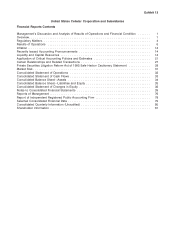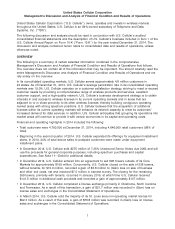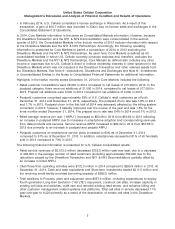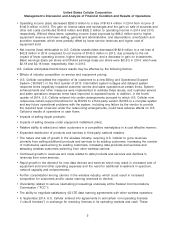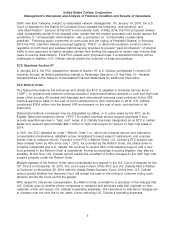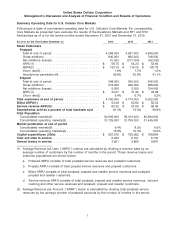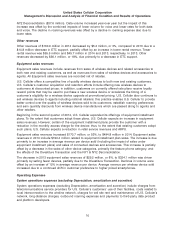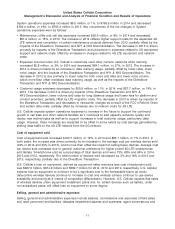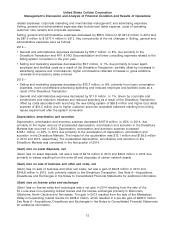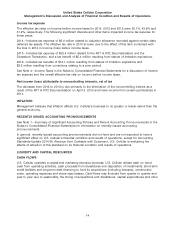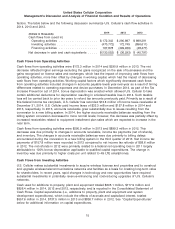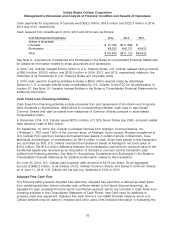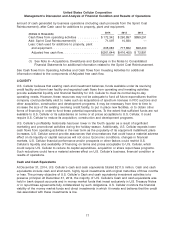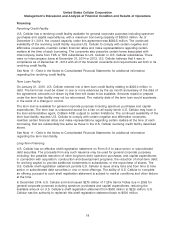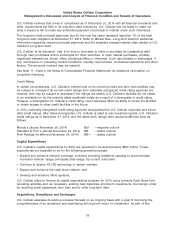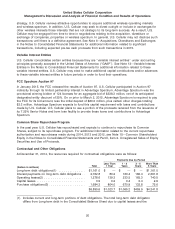US Cellular 2014 Annual Report Download - page 18
Download and view the complete annual report
Please find page 18 of the 2014 US Cellular annual report below. You can navigate through the pages in the report by either clicking on the pages listed below, or by using the keyword search tool below to find specific information within the annual report.United States Cellular Corporation
Management’s Discussion and Analysis of Financial Condition and Results of Operations
NY2 Deconsolidation ($37.6 million). Data volume increased year-over year but the impact of this
increase was offset by the combined impacts of lower volume for voice and lower rates for both data
and voice. The decline in roaming revenues was offset by a decline in roaming expense also due to
lower rates.
Other revenues
Other revenues of $160.9 million in 2014 decreased by $5.2 million, or 3%, compared to 2013 due to a
$14.8 million decrease in ETC support, partially offset by an increase in tower rental revenue. Tower
rental revenue was $55.5 million and $45.7 million in 2014 and 2013, respectively. In 2013, Other
revenues decreased by $36.1 million, or 18%, due primarily to a decrease in ETC support.
Equipment sales revenues
Equipment sales revenues include revenues from sales of wireless devices and related accessories to
both new and existing customers, as well as revenues from sales of wireless devices and accessories to
agents. All Equipment sales revenues are recorded net of rebates.
U.S. Cellular offers a competitive line of quality wireless devices to both new and existing customers.
U.S. Cellular’s customer acquisition and retention efforts include offering new wireless devices to
customers at discounted prices; in addition, customers on currently offered rate plans receive loyalty
reward points that may be used to purchase a new wireless device or accelerate the timing of a
customer’s eligibility for a wireless device upgrade at promotional pricing. U.S. Cellular also continues to
sell wireless devices to agents including national retailers; this practice enables U.S. Cellular to provide
better control over the quality of wireless devices sold to its customers, establish roaming preferences
and earn quantity discounts from wireless device manufacturers which are passed along to agents and
other retailers.
Beginning in the second quarter of 2014, U.S. Cellular expanded its offerings of equipment installment
plans. To the extent that customers adopt these plans, U.S. Cellular expects an increase in equipment
sales revenues. However, certain of the equipment installment plans provide the customer with a
reduction in the monthly access charge for the device; thus, to the extent that existing customers adopt
such plans, U.S. Cellular expects a reduction in retail service revenues and ARPU.
Equipment sales revenues increased $170.7 million, or 53%, to $494.8 million in 2014. Equipment sales
revenues in 2014 include $190.4 million related to equipment installment plan sales. The increase is due
primarily to an increase in average revenue per device sold (including the impact of sales under
equipment installment plans) and sales of connected devices and accessories. This increase is partially
offset by a decrease in the sales of other device categories, primarily the feature phone category, and
the effects of the Divestiture Transaction and the NY1 & NY2 Deconsolidation.
The decrease in 2013 equipment sales revenues of $29.2 million, or 8%, to $324.1 million was driven
primarily by selling fewer devices, partially due to the Divestiture Transaction. Declines in volume were
offset by an increase of 12% in average revenue per device. Average revenue per wireless device sold
increased due to a continued shift in customer preference to higher priced smartphones.
Operating Expenses
System operations expenses (excluding Depreciation, amortization and accretion)
System operations expenses (excluding Depreciation, amortization and accretion) include charges from
telecommunications service providers for U.S. Cellular’s customers’ use of their facilities, costs related to
local interconnection to the wireline network, charges for cell site rent and maintenance of U.S. Cellular’s
network, long-distance charges, outbound roaming expenses and payments to third-party data product
and platform developers.
10


